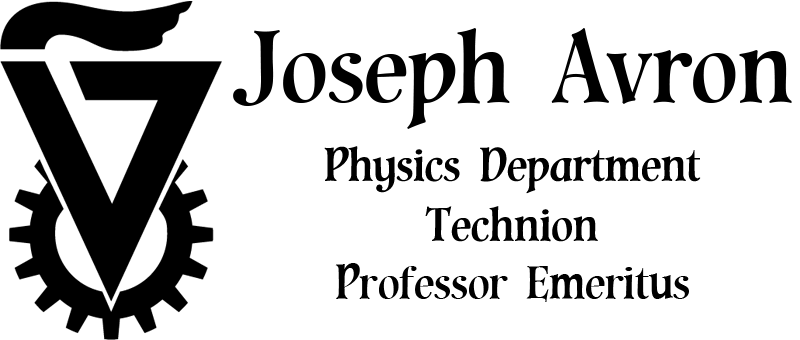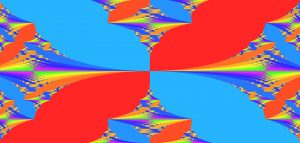I am interested in “quantum engineering”: application of quantum mechanics. I do theory, and like elegant mathematics geometry, and animations.
You may enjoy the visualizations even if the mathematics and physics does not really interest you.
Publications:
- arXiv au: Avron_J
- Complete list + citations from Google
Podcast
- עושים טכנולוגיה. ישראל ומיחשוב קוונטי – יחסינו לאן? פודקסט על מיחשוב קוונטי
Video lectures:
- Lindblad evolutions and Born rule, Quantum Simulations and Computations, Kfar Bloom 2022
- EPR-Einstein’s most cited paper and the story of entanglement (2021)
- A century of adiabaticity zoom lecture at Joel Lebowitz seminar, December 2020 (Rutgers)
- האלגוריתם של שור-הרצאה בבית הספר לקוונטים של מכון דילר 2020
- מחשבים קוונטים: שחר של יום חדש (הרצאה בת שעתיים בזום באינטל 2020
- הרצאה בקורס תגליות מדעיות בטכניון 2020) :מחשבים קוונטים: איום והבטחה)
- On the proof of Hastings and Michalakis, Oaxaca 2019
- Quantum computers and Shor algorithm (Hebrew) part 1(1:15), part 2 (0:34). The pdf file
- בעיה כבדת משקל: ניוטון מול איינשטיין כנס ניוטון 2018: מדע, אמונה והמאה ה 21
- 2016 Physics Nobel Prize: D. Thouless and Topological quantum numbers, Technion, (2017)
- על דתלשים ולימודי ליבה דברים בטקס פרס ינאי 2015
- Topological quantum numbers in open systems, Banff, (2013).
- Baron von Munchhausen and the cat, KITP colloquium, (2011).
- Topological quantum numbers, Jerusalem winter school (2011).
- Quantum swimming, Newton Institute, Cambridge, (2007).
- Should biologists care about quantum computing?, RBNI winter school, Dead Sea, (2010).
- 2011 טלפורטציה: מרכז אילן רמון אוניברסיטת בן גוריון
- (אינפורמציה קוונטית (קורס
- (מכניקה אנליטית (קורס
Zoom Lectures:
- Quantum games: The Mermin-Peres Magic square, lecture at the Mathematical Physics Webinar at Rutgers University, 16 August 2023
Video course (Hebrew):
- אינפורמציה קוונטית (youtube)
- מכניקה אנליטית (youtube)
(Semi-) Popular:
- Determinism in physics: Classical & quantum. (Faculty of Medicine, Technion. 2024)
- Nathan Rosen: His life and science A story of entanglement (PDF file, Video lecture in English) (2021)
- Quantum computers: The next industrial revolution? (2021)
- Quantum computers: The dawn of a new age (Intel 2020)
- Quantum computers: Threats and promises , Multi Dimensional Metrology Conference 2018
- An issue with gravity: Newton vs Einstein (pdf, Video lecture in Hebrew)
- The advantage of a quantum computer: Deutsch algorithm
- Topological quantum states and the 2016 Nobel prize, Bull. IAMP
- תגליות מדעיות: נובל 2016 טופולוגיה ומכניקה קוונטית
- Turning the wheels of a quantum motor, Physics 6 (2013)
- אודיסיאה: טלפורטציה קוונטית
- A Topological Look at the Quantum Hall Effect, Physics Today 56, (2003), 38-42.
- תגליות מדעיות: טלפורטציה קוונטית
Blog
- Energy, momentum and gauge transformations
- Alex Grossmann (video)
- Kelvin wake
- Constant curvature: A solution to a 20 years old problem
- Mini introduction to information theory to undergrads
- Current carrying wire
App
- Matalab program for colored Hofstadter butterflies , D. Osadchy, MSc thesis
- Colored Hofstadter buttterfly: High resolution image. Courtesy of D. Osadchy
- Webb based app for testing separability of quantum states: States separator, a project carried by N. Shalev and O. Messer
Lectures (pdf):
- Quantum Games, the Hebrew university of Jerusalem, November 2024
- Quantum games: The Mermin-Peres magic square, July 2023
- Quantum: Threats and promises, Quantum session for social sciences and humanities, Haifa University, June 2023
- 2022 Nobel Prize, Technion Physics colloquium, May 2023
- Born rule for Lindblad evolutions, Lecture at the Quantum Computing conference, Kfar Bloom, 2022
- An invitation to Zak phase, Korea-Israel meeting, the Academy of Science, Jerusalem 2022
- Risorgimento della vita felice, Zurich, 2022
- An introduction to Zak phase: Fun with 2×2 matrices, Strasbourg 2022
- Shor in short, Haifa University 2022
- A century of adiabaticity, Rutgers, 2020
- Shor algorithm in times of Corona, Lecture at the Diller Summer school 2020 (Slides in English, video in Hebrew)
- Braiding flluxes in Pauli Hamiltonians, Shanghai 2019
- Hall conductance for large interacting systems, Nordita 2019
- Quantum computers and Shor algorithm: Crash course, רפא”ל 2019
- Odd viscosity: Hall viscosity for the neophyte, WIS 2018
- The geometry of 1,2 and n qubits, Torun, Poland 2018
- Geometry of qubits, Haifa, 2018
- Flexible Ring Interferometers, Smilansky Fest, Rehovot, 2016.
- Vignettes, Barry Simon Fest, Montreal 2016
- 4 Lectures on Adiabatic Quantum Transport, La Sapienza, Rome, 2016
- Bar-Ilan Colloquium: Tutorial on Fredholm index interpretation of the Quantum Hall effect (2016)
- Adiabatic transport in Open Systems (Koln 2015)
- Two tutorial lectures on the Quantum Hall Effect, Chern numbers, Fredholm Index, ESI, Vienna (2014)
- Braiding fluxes in Pauli Hamiltonians, (Hebrew University, 2016) SISSA (2014), Montreal, (2014)
- Entanglement for pedestrians, Colloquium, Weizmann (2014)
- Adiabatic response in open systems, Kfar Blum (2012)
- Transport in open systems, KITP, (2011)
- The Baron and the Cat KITP, (2011)
- Jerusalem winter school 2010
- Swimming in curved space (Technion 2011)
- Geometry of response in open systems (CRM Montreal 2011)
- Visualizing 2 qubits (Caltech 2011)
- Geometry of transport in open systems (Caltech, Harvard, MIT 2011)
Lecture notes:
- Quantum information
- Electrodynamics
- Classical Thermodynamics (draft)
- Lagrangian and Hamiltonian Mechanics
Recent Graduate students and thesis:
- Amit Tsabary, Dissipation in Linear and Nonlinear Models of Quantum Systems, 2017
- Rotem Berman, Swimming and alignment in low Reynolds numbers, 2014
- Michael Shalyt, Control of a 2-Level System to Reduce Colored Noise, 2013.
- Lev Kvitny, Entanglement in Quantum States, 2011.
- Eli Meirom, Entanglement in Radiative caascades, 2008.
- Oren Raz, Swimming, Pumping and Gliding at Low Reynolds Number, 2007.
- Gili Bisker, The world of two qubits, 2007
Wikipedia
- יהושע זק
- הנס קרוך
- אשר פרס
- דב אברון
- אפקט סניאק
- Sagnac effect
- Stokes’ paradox, Yacov Nir Breitstein, project
- State separator, a web app for testing separability, contributed entry to Quantum entaglement, O. Messer, project
Animations:
Microswimmers:
The motion of small organisms and microbots is dominated by viscosity and inertia is largely irrelevant. This makes this mode of locomotion foreighn and unituitive. Its mathematical appeal comes from the fact that it is geometric in character.
Pushmepulyou versus three linked sphere
Pushmepulyou: The three linked spheres is an elegant model of a microswimmer invented by Njafy and Golestanian. Inspiredd by their work, David Oaknin, Oded Kenneth and I invented Pushmepulyou. By pressing START you will see a swimming competition between the two swimmers. For more informatio see.
Purcell swimmer: Perhaps the most important caricature of a micro-swimmer is the one invented by Purcell. It is made of three linked rods and mimics a flagellum, it also illustrates the unintuitive nature of the motion at low Reynolds numbers and it is a challenge to guess (given the stroke) it will swim. It is also very hard to analyze mathematically. Together with my student, Oren Raz, we invented a symmmetric version of Purcell swimmer which is intuitive and that removes some of the mystery. For more see.
Falling cats
Cats always fall on their feet and they do so without relying angular momentum. Rotations at zero zangular momentum look surprising, but they are possible if a body is deformable. The image of a cat in the animation above shows how a sequence of non-commuting deformations lead to a rotation. This is a simple example of holonomy. The mathematical description is quite pretty and geometric and there is huge literature on this problem. For my work see.
Baron von Munchhausen or Swimming in empty curved space
Baron von Munchhausen claimed to have pulled himself, and his horse, out of a swamp by pulling on his hair. This is a tall story because it conflicts with Newton’s laws. However, as Jack wisdom noted it is not such a tall stroy in a curved space. Wisdom was interested in swimming away from blach holes. Together with Oded Kenneth we developed a theory of swimming of deformable bodies in isotropic and homogeneous spcaces. In the animation above, the same stroke propagates the swimmer in opposite directions because the curvature of the ambient space is opposite.
Swimming on a surface with negative curvature
Hofstadter butterflies and the Quantum Hall effect
The colored Hofstadter butterfly shown below is pretty fractal, pictures that arises from the solution of an simple looking single linear equation that is a model of the quantum Hall effect. The picture was made by my student Daniel Osadchy as part of his MSc. A Matlab code for making the picture is available from his home page. and it is called a hofstadter butterly because Douglas Hofstadter, the author of the best seller “Goedel Escher Bach” made the black and white version of the butterfly back in 1976. The colors in the diagram represent intgeres known mathematically as Chern number and physically as the quantized values of the Hall conductance. These integers were not known in 1976: The Hall effect was only discovered in 1980 by Klaus von Klitzing, who recieved a Nobel prize for it. David Thouless and coauthors, TKNN, studied the Hosftader model in this context and showed that the Hall conductance is related to Chern numbers. For more, see.
Optimal swimming strokes for microswimmers
What determines the size and shape of an optimal stroke of microswimmers? In the animation the one sees that the stroke ends when the shape developes a cusp. Together with Gat and Kenneth we gave a detailed analysis of the problem of two dimensional swimmers using conformal techniques. For more see

